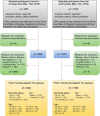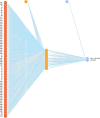Develop a diagnostic tool for dementia using machine learning and non-imaging features
- PMID: 36092811
- PMCID: PMC9461143
- DOI: 10.3389/fnagi.2022.945274
Develop a diagnostic tool for dementia using machine learning and non-imaging features
Abstract
Background: Early identification of Alzheimer's disease or mild cognitive impairment can help guide direct prevention and supportive treatments, improve outcomes, and reduce medical costs. Existing advanced diagnostic tools are mostly based on neuroimaging and suffer from certain problems in cost, reliability, repeatability, accessibility, ease of use, and clinical integration. To address these problems, we developed, evaluated, and implemented an early diagnostic tool using machine learning and non-imaging factors.
Methods and results: A total of 654 participants aged 65 or older from the Nursing Home in Hangzhou, China were identified. Information collected from these patients includes dementia status and 70 demographic, cognitive, socioeconomic, and clinical features. Logistic regression, support vector machine (SVM), neural network, random forest, extreme gradient boosting (XGBoost), least absolute shrinkage and selection operator (LASSO), and best subset models were trained, tuned, and internally validated using a novel double cross validation algorithm and multiple evaluation metrics. The trained models were also compared and externally validated using a separate dataset with 1,100 participants from four communities in Zhejiang Province, China. The model with the best performance was then identified and implemented online with a friendly user interface. For the nursing dataset, the top three models are the neural network (AUROC = 0.9435), XGBoost (AUROC = 0.9398), and SVM with the polynomial kernel (AUROC = 0.9213). With the community dataset, the best three models are the random forest (AUROC = 0.9259), SVM with linear kernel (AUROC = 0.9282), and SVM with polynomial kernel (AUROC = 0.9213). The F1 scores and area under the precision-recall curve showed that the SVMs, neural network, and random forest were robust on the unbalanced community dataset. Overall the SVM with the polynomial kernel was found to be the best model. The LASSO and best subset models identified 17 features most relevant to dementia prediction, mostly from cognitive test results and socioeconomic characteristics.
Conclusion: Our non-imaging-based diagnostic tool can effectively predict dementia outcomes. The tool can be conveniently incorporated into clinical practice. Its online implementation allows zero barriers to its use, which enhances the disease's diagnosis, improves the quality of care, and reduces costs.
Keywords: Alzheimer’s disease; dementia; early diagnostic tool; machine learning; non-imaging factors.
Copyright © 2022 Wang, Sheng, Xu, Jin, Jin, Qiao, Chen, Xing, Zhao, Yan, Mao and Xu.
Conflict of interest statement
The authors declare that the research was conducted in the absence of any commercial or financial relationships that could be construed as a potential conflict of interest.
Figures






Similar articles
-
Machine learning-based risk prediction of hypoxemia for outpatients undergoing sedation colonoscopy: a practical clinical tool.Postgrad Med. 2024 Jan;136(1):84-94. doi: 10.1080/00325481.2024.2313448. Epub 2024 Feb 5. Postgrad Med. 2024. PMID: 38314753
-
Ensemble Model for Diagnostic Classification of Alzheimer's Disease Based on Brain Anatomical Magnetic Resonance Imaging.Diagnostics (Basel). 2022 Dec 16;12(12):3193. doi: 10.3390/diagnostics12123193. Diagnostics (Basel). 2022. PMID: 36553199 Free PMC article.
-
Can Predictive Modeling Tools Identify Patients at High Risk of Prolonged Opioid Use After ACL Reconstruction?Clin Orthop Relat Res. 2020 Jul;478(7):0-1618. doi: 10.1097/CORR.0000000000001251. Clin Orthop Relat Res. 2020. PMID: 32282466 Free PMC article.
-
Non-Contrasted CT Radiomics for SAH Prognosis Prediction.Bioengineering (Basel). 2023 Aug 16;10(8):967. doi: 10.3390/bioengineering10080967. Bioengineering (Basel). 2023. PMID: 37627852 Free PMC article.
-
Interpretable machine learning model to predict surgical difficulty in laparoscopic resection for rectal cancer.Front Oncol. 2024 Feb 6;14:1337219. doi: 10.3389/fonc.2024.1337219. eCollection 2024. Front Oncol. 2024. PMID: 38380369 Free PMC article. Review.
Cited by
-
Neural Computation-Based Methods for the Early Diagnosis and Prognosis of Alzheimer's Disease Not Using Neuroimaging Biomarkers: A Systematic Review.J Alzheimers Dis. 2024;98(3):793-823. doi: 10.3233/JAD-231271. J Alzheimers Dis. 2024. PMID: 38489188 Free PMC article.
-
XGBoost models based on non imaging features for the prediction of mild cognitive impairment in older adults.Sci Rep. 2025 Aug 13;15(1):29732. doi: 10.1038/s41598-025-14832-0. Sci Rep. 2025. PMID: 40804281 Free PMC article.
-
Artificial intelligence detection of cognitive impairment in older adults during walking.Alzheimers Dement (Amst). 2024 Sep 26;16(3):e70012. doi: 10.1002/dad2.70012. eCollection 2024 Jul-Sep. Alzheimers Dement (Amst). 2024. PMID: 39328904 Free PMC article.
-
Combination of static and dynamic neural imaging features to distinguish sensorineural hearing loss: a machine learning study.Front Neurosci. 2024 Jun 12;18:1402039. doi: 10.3389/fnins.2024.1402039. eCollection 2024. Front Neurosci. 2024. PMID: 38933814 Free PMC article.
-
Detection of Alzheimer's Disease Using Logistic Regression and Clock Drawing Errors.Brain Sci. 2023 Jul 29;13(8):1139. doi: 10.3390/brainsci13081139. Brain Sci. 2023. PMID: 37626495 Free PMC article.
References
-
- Aderghal K., Khvostikov A., Krylov A., Benois-Pineau J., Afdel K., Catheline G. (2018). “Classification of Alzheimer disease on imaging modalities with deep CNNs using cross-modal transfer learning,” in 2018 IEEE 31st International Symposium on Computer-Based Medical Systems (CBMS), (New York, NY: IEEE; ), 345–350. 10.1109/CBMS.2018.00067 - DOI
-
- Akay M. F. (2009). Support vector machines combined with feature selection for breast cancer diagnosis. Expert Syst. Appl. 36 3240–3247. 10.1016/j.eswa.2008.01.009 - DOI
-
- Albert M. S., DeKosky S. T., Dickson D., Dubois B., Feldman H. H., Fox N. C., et al. (2011). The diagnosis of mild cognitive impairment due to Alzheimer’s disease: Recommendations from the National Institute on Aging-Alzheimer’s Association workgroups on diagnostic guidelines for Alzheimer’s disease. Alzheimers Dement. 7 270–279. 10.1016/j.jalz.2011.03.008 - DOI - PMC - PubMed
-
- Amato F., López A., Peña-Méndez E. M., Vaňhara P., Hampl A., Havel J. (2013). Artificial Neural Networks in Medical Diagnosis. Amsterdam: Elsevier. 10.2478/v10136-012-0031-x - DOI
LinkOut - more resources
Full Text Sources

